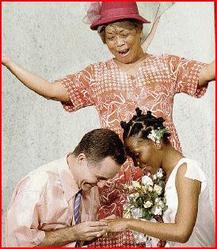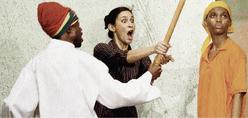
Godfrey, played by Jean-Paul Menou, weds Monica (Sakina) as Miss Chin (Ruth Ho Shing) is all smiles, in a scene from 'Which Way Is Out?'
The title may be obscure but the audience which was in attendance last Sunday for Which Way Is Out? partook in a tragicomedy buffet served on a platter of delightful acting and a great story.
Written by Basil Dawkins and staged at The Little Little Theatre on Tom Redcam Avenue, Which way Is Out? epitomises two popular Jamaican sayings: 'Woman luck deh a dungle heap an fowl scratch it up' and 'Weh nuh dead nuh dash weh'.
Monica, played by Sakina (who does not use her last name), is a poor girl who experiences a difficult life. She has no relatives and lives in a tenement yard. She survives by selling stolen bottles and crediting goods from Miss Chin's (Ruth Ho Shing) shop. That is until Godfrey (Jean-Paul Menou), a white, American tourist, falls in love with her, marries her and takes her to his homeland.
But life in the United States provides more challenges for Monica following the death of Godfrey and her being framed by Ava (Maylynne Walton), one of her sisters-in-law. She eventually overcomes them and returns to Jamaica a wealthy, refined woman, but sounding every bit her old self.
The strengths of Which Way Is Out? lie not only in the great story, but also in the humorous language, the rising action, growth of the main character, Monica, and excellent employment of acting skills and beautiful timing by the cast, some of whom played two characters.
Strenghts of the play
Leading the charge of talents was Ho Shing, who also played Sophie, a US lawyer. Both roles were executed with conviction: Miss Chin, a money-loving shopkeeper and Sophie the assertive lawyer.
Menou and Walton were very sound in the portrayal of their characters: Walton's two faces of Eve in the evil Ava and good Eve were fantastic, while Menou looked and behaved like a real American tourist.
Donald Anderson as Eustace the country man was just as excellent in his role as Jah Collie, the undocumented Jamaican in the US. He was hilarious to a fault in his delivery and timing.
But Sakina was the main menu. She embraced Monica with the vigour of a long-lost sister and presented her to the audience as a witty, developed character. The crazy-looking Monica shown at the beginning of the play who blossomed into a more focused individual at the end is a testimony of Sakina's talent.
Douglas Prout directed well for the most part: moving the action in all the acting areas, with one entrance through the audience. But Prout's decision in some entrances also gave cause for concern as well as the mixing of styles, realistic and non-realistic. For example, in the restaurant scene an invisible door and a glass containing a green drink make a poor combination.
The set was designed by Eugene Williams. Williams is known for great directing and some good set designs over the years, but history will not recall his design for Which Way Is Out? as one of his best. The set, designed to be multifunctional, a shop, an apartment, etc, did not provide such flexibility. It was flat, lacked imagination and seemed more cumbersome than functional, like the permanent banana leaves and the US flag painted on the wall regardless of the change in location.
Pros and cons
The costumes, designed by Qunidell Ferguson, were generally suitable, except for the dress that Monica wears to the embassy and the unclean outfit when she was on the streets. In the end, Monica looks like a crazy person rather than a strong and resilient homeless person.
However, the pros far outweigh the cons and Which Way Is Out? is definitely a must-see for the entire family.
